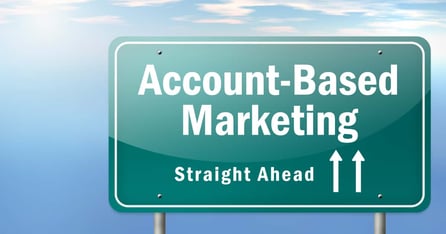Account-Based Marketing Quiz: Is ABM For Your Company?

You may have heard about Account-based marketing (ABM) and want to find out if this modern, highly effective, and common-sense strategic approach can grow your business. It will take some organizational realignment and a commitment to digital customer engagement to implement.
But unequivocally, it’s worth it to investigate the impact it could have on your business. And when the potential outcome is so attractive, who’s going to take issue with a little sweat equity? Account-based marketing can fundamentally change the way you do business — and we have seen the results firsthand with our own clients.
What is Account-Based Marketing (ABM)?
Account-based marketing (ABM) is a business marketing strategy that concentrates resources on a set of target accounts within a market. It uses personalized campaigns designed to engage each account, basing the marketing message on the specific attributes and needs of the account.
Sounds simple, right? Focus on your best opportunities and don’t kid yourself into thinking that the old, long-ignored company website or trifold brochure is going to cut it.
Take time to get to know your target and what their expectations of your organization really are and, for the love of all things holy, adopt a digital strategy for success because — don’t panic here — all of your competitors are. Oh, and by the way, that neglected website will become a vitally important component of your ABM strategy.
Our friends at HubSpot have some interesting data on why ABM is an increasingly compelling solution for businesses that sell:
- 57% of B2B purchase processes are completed before a buyer even contacts a vendor.
- Your traditional marketing materials aren’t as effective as you might think — third-party review sites, peer-to-peer recommendations, and word of mouth play an increasingly important role.
- Trust in businesses is in a nosedive — 81% of buyers trust advice from friends and family over companies.
- And finally, 55% report trusting the businesses they buy from less than they used to.
Ten Key Considerations to find out if Account-Based Marketing Makes Sense For Your Company
ABM may make a lot of sense for your company if your product costs a significant amount of money, you have a finite or limited number of prospects, or you regularly sell to a buying committee. It will result in bigger deal size, better sales and marketing coordination, and certainly better sales velocity.
On the face of it, what could be easier or make more sense? The challenge comes in implementing this kind of approach in a company locked into doing things a certain way, or if not all elements of the organization are in alignment. If your company is managing hundreds if not thousands of customers at varying stages of development, it could be tough to make the transition.
To really find out if an ABM business orientation makes sense, here are ten key considerations to pose to your organization:
1. Your business depended on trade shows
Trade shows, long a reliable source of new business, are in flux. You’ve been without them for a year and the online versions are a shadow of what being there in person was. Maybe you’ve signed up for an in-person version in the Fall. But what happens if no one shows?
And what if trade shows were never the best way to grow your business in the first place? Trade shows may still be a strong option for your business (and with the right plan, you can maximize your trade show ROI), but they shouldn’t be your only source of leads.
2. Your sales and marketing teams are more like the Hatfields and the McCoys
Your sales and marketing teams appear to be at odds with one another as opposed to working collaboratively. The current business climate is challenging enough without core members not being on the same page. Account-based marketing forges a spirit of cooperation and shared purpose that is hard to beat.
3. “This is the way Granddad ran the business”
These are the most dangerous words in business today. Your go-to-market strategy has barely evolved from when the company started in business several generations ago. While the products you produce may not have changed much over the last couple of decades, the way to get them in front of key prospects has. Time to modernize your approach.
4. Once sleepy competitors are using new tactics to encroach on your business
Competitors are ruthlessly targeting your customer base — and customers you thought were loyal are defecting, or, at least, listening. If you are on top of what your competition is doing to market their product or service and you’ve noticed a change and are not sure why, that’s a red flag.
Everyone evolves to a new normal at a different pace but if the market has raced ahead of you, now is the time to catch up.
5. The buyer is in charge
Prospects are now more firmly in control of the sales process and may come to a first meeting knowing more about your business than you might have ever thought possible. You’ve been researched, probed, and pressure tested without even knowing it.
How are you feeling now about that website and demand generation plan developed in 2015? Time to understand what your prospect is looking for in terms of content and delivering on that need consistently.
6. Your lead process is lengthy and complex and your plan to manage it is unfocused and inconsistent
The size, cost, and complexity of your deals require hours of coordinated staff time to execute — and your current approach is ad hoc and inconsistent. Again, if your organization is not focused on a singular approach to the market you are doing your bottom line a major disservice.
7. You don’t really know the decision-maker
Your deals are not one-to-one handshake arrangements. You are selling to customer committees, not all of whom are your friends. Start to address the key constituencies in the room versus a one-size-fits-all approach.
8. Aside from some product updates, you haven’t touched your website since Peyton Manning was with the Colts
Your website must be seen as a growth engine, not a digital brochure. Relevant content refreshed constantly that is highly engaging for your most valuable prospects is critical.
9. You don’t know when and where to exert maximum organizational effort to get deals closed
All deals are not created equal. Some are almost self-guided while others take significant resources to land, and you may not always be sure which is which. Account-Based Marketing leaves no discussion about where to spend your effort.
10. You don’t have much of a CRM
If your CRM system consists of a rusty file cabinet, please read on!
We met with a prospect recently who had over 50,000 customer contact records in a “homemade” system managed by one member of staff. In a scenario such as this, almost too stressful to contemplate, what is the impact to the business if you stroll in one Monday morning and find out that this person has quit, been taken by aliens, or simply needs to take a week to two off? How quickly do things grind to a halt?
Just as the healthcare field finally accepted that health records in manila folders were an ineffective way to manage the health of thousands of patients, so too has modern business come to an important conclusion.
Management of thousands of complex ongoing and prospective business relationships — each with their own nuance, time horizons, and personality characteristics — demands a comprehensive solution. Oversight of this kind of depth and breadth of information is beyond the capabilities of most CRM systems and all human beings.
Account-Based Marketing – Significant Value for Businesses
ABM is a relatively new concept, is in the process of iteration, takes some work to implement, and requires a digitally based reorientation for your company. But it makes fundamentally good business sense.
The more care and attention paid to high-value customers, the bigger the return on investment. Its potential for your business could be significant. To paraphrase everyone’s favorite show about nothing, “ABM is real, and it’s spectacular.”
New Perspective has worked with a number of companies who have made the effort, done the work behind the scenes to get their teams aligned around ABM, and are glad that they did. One example is a client of ours in the renewable energy space. We started working with them about a year ago as they looked to rebrand and repurpose the company — from an industry products seller within the space to one focused on providing end-to-end industry solutions.
Convincing the industry to see them in a different light was a considerable undertaking, but it paid off. Today they have a new brand presence and a new website with an integrated, best-in-class CRM system in place.
They’ve made an organizational commitment to continually produce new, relevant content targeted to engage and delight the prospects they seek to turn into loyal, high-value customers. Now, quality leads are flowing and the business is generating increased profits as they move towards their goal of $100 million in global revenues by 2025. Their future looks bright indeed.
Wondering whether Account-based marketing is right for your business? Take our free ABM assessment. It will help you determine whether a strong ABM strategy could benefit your business and help you capture more high-quality, good-fit leads.




